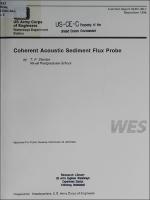Please use this identifier to cite or link to this item:
https://hdl.handle.net/11681/2800| Title: | Coherent acoustic sediment flux probe |
| Authors: | Naval Postgraduate School (U.S.) Stanton, T. P. |
| Keywords: | Acoustics Concentration profiles Sediment transport Suspension Coherent Acoustic Sediment Flux Probe CASP Equipment Instruments Doppler effect Probes Remote sensing |
| Publisher: | Coastal Engineering Research Center (U.S.) Engineer Research and Development Center (U.S.) |
| Series/Report no.: | Contract report (U.S. Army Engineer Waterways Experiment Station) ; CERC-96-1. |
| Description: | Contract Report Abstract: A high-resolution, three-component sediment flux probe has been developed to meet the objectives outlined by the National Academy of Science Panel on Coastal Engineering Measurements using very high-frequency coherent acoustic doppler techniques. The Coherent Acoustic Sediment Flux Probe (CASP) system consists of an underwater housing equipped with three 5.2-MHz acoustic transceivers, a single 1.4-MHz transceiver, a pair of precision tilt sensors to correct package orientation tilts, and electronic processing and control modules which output a high-speed digital data stream to a shore-based processing computer. The instrument package is typically positioned looking downward at the bottom boundary layer to sample the velocity vector and serliment flux vector at a primary measurement volume 25 cm in front of the instrument head. In addition, profiles of sediment concentration are estimated every 1.68 em along each of the four narrow acoustic beams. Suspended sediment concentrations are inferred from profiles of acoustic backscatter acoustic intensity by measuring the range-gated power returns from the 1.4-MHz transceiver and each of the 5.2-MHz transceivers. The backscatter power levels are converted to sediment concentration profiles using an acoustic model which includes the effects of attenuation due to water and suspended mass, and radial spreading, to produce profiles from 6 cm in front of the instrument head to the sediment bed, up to a range of 1.2 m. Under restricted conditions, the ratio of backscatter measured by the 1- and 5-MHz transceivers can be used to identify changes in the mean sediment size. |
| Rights: | Approved for public release; distribution is unlimited. |
| URI: | http://hdl.handle.net/11681/2800 |
| Appears in Collections: | Contract Report |
Files in This Item:
| File | Description | Size | Format | |
|---|---|---|---|---|
| CR-CERC-96-1.pdf | 12.76 MB | Adobe PDF |  View/Open |